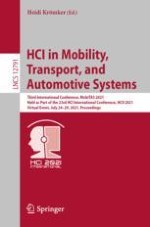2021 | OriginalPaper | Buchkapitel
Modeling of Onboard Activities: Public Transport and Shared Autonomous Vehicle
verfasst von : Jamil Hamadneh, Domokos Esztergár-Kiss
Erschienen in: HCI in Mobility, Transport, and Automotive Systems
Aktivieren Sie unsere intelligente Suche, um passende Fachinhalte oder Patente zu finden.
Wählen Sie Textabschnitte aus um mit Künstlicher Intelligenz passenden Patente zu finden. powered by
Markieren Sie Textabschnitte, um KI-gestützt weitere passende Inhalte zu finden. powered by
